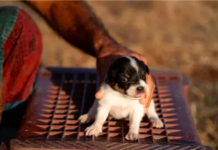Last Updated on October 10, 2023 by Fumipets
17 Exploring the Rich Diversity of German Horse Breeds
German horse breeds have earned a reputation for their excellence in various equestrian disciplines. Germany boasts several distinct horse breeds, each with its unique characteristics and history.
These breeds are known for their versatility, strength, and suitability for different riding and work purposes, making them highly regarded in the equine world.
German Horse Breeds
Several prominent breeds of horses now originated in Germany, which has had a significant influence on the equestrian world. Ponies, warmbloods, and coldbloods are plentiful across the nation and are quite useful to their owners. While their tasks may have evolved with time, their souls have not.
You’ve found the ideal website if you need to brush up on your knowledge of German horses. The top 17 horse breeds from the country of poets and philosophers are listed here.
The 17 German Horse Breeds
1. Arenberg-Nordkirchen

Height: 13-13.5 hands
Weight: 800 pounds
Purpose: Sport, hobby
Colors: bay, black, dun, chestnut, and gray
Smaller, sleek, and slender, the Arenberg-Nordkirchen is a breed of horse from Germany. They were assumed to be extinct in the 1880s. Yet since 1999, they have reemerged and remained steady.
Thanks to the Duke of Arenburg and the horses on his estate, the Arenberg-Nordkirchen breed was established in 1923. They are now thought to be critically endangered.
2. Bavarian Warmblood

Height: 15-16 hands
Weight: 1,000-1,300 pounds
Purpose: Jumping, show-jumping, dressage
Colors: all solid colors, including sorrel, bay, and black. No white markings are allowed—otherwise, it is a breed defect.
A proud Rottaler ancestor, the Bavarian Warmblood was created in Southern Germany. These unusual horses might be seen participating in competitions and leisurely walks.
The Bavarian Warmblood is renowned for its smooth movements, steady pace, and agility. They trot in a highly rhythmic manner.
3. German Classic Pony

Height: 11 hands
Weight: 400-425 pounds
Purpose: Riding, driving
Colors: Any coat color is acceptable, but flaxen chestnut is the most prevalent.
The German Traditional Pony is a small cutie with tufts of hair. Despite the fact that this breed was just developed in 1965, they are already rare. Even after 2001, they had not yet been recognized as a German breed.
German Classic Ponies can handle heavy work since they are robust and sturdy. It is a cross between Scotch and Shetland ponies, often used for light labor.
4. German Riding Pony

Height: 13-14 hands
Weight: 700 to 800 pounds
Purpose: Dressage, jumping, riding
Colors: grullo, perlino, gray, brown, white, palomino, roan, champagne, dun, and buckskin
The German Riding Pony, sometimes called the Deutsche Reitpony, is an elegant, competent animal with appealing characteristics. The general consensus is that these ponies may be thought of as tiny copies of their German Warmblood relatives.
Little or unskilled riders might do well with this pony. These horses are agile and purposeful in their movements.
5. Hanoverian

Height: 15-17 hands
Weight: 1,400 pounds
Purpose: Competition, Olympics
Colors: gray, bay, chestnut, and black.
In Olympic contests, the classy Hanoverian has a significant position. They are lovely and fiercely competitive English riding horses.
During World War I, Hanoverians had enormous popularity. These horses have persisted throughout the years despite population loss, making them an important breed today.
6. Hessian Warmblood

Height: 15-16 hands
Weight: 1,000 pounds
Purpose: Riding
Colors: can come in a broad spectrum of color, but most often chestnut and brown.
Hessian Warmbloods are great at carrying both their own and everyone else’s burdens. For both light and heavy riders, these horses are the best options. They have a powerful energy that makes a rider feel at ease and comfortable.
They are regarded as a first-class German breed because of their steady movement. They move with timing and accuracy while maintaining a comfortable posture.
7. Holsteiner

Height: 16 to 17 hands
Weight: 1,025 pounds
Purpose: Eventing, dressage, show jumping
Colors: black, brown, bay, chestnut, and gray.
The superb Holsteiner is regarded as Germany’s oldest warmblood breed. These gifted horses are experts in a variety of fields.
One of these horses may be seen competing in the sports of eventing, dressage, combined driving, and show jumping. Holsteiners may identify themselves by a brand mark on their left hip. Horse enthusiasts all across the world covet and appreciate these animals.
8. Mecklenburger

Height: 15-17 hands
Weight: 1,000 pounds
Purpose: Combined driving, eventing, competition
Colors: chestnut, black, bay, or gray.
The Mecklenburger is an athletic, precise warmblood with a medium weight. They are described as being reposed and possessing a highly balanced temperament.
A quick German horse that was originally used for work, the Mecklenburger. They served as saddle horses or carriage horses after the war. As the Mecklenburger began to perform new duties as a sport horse in the 1970s, things started to change.
9. Oldenburg Horse

Height: 16-17 hands
Weight: 1,700 pounds
Purpose: Jumping, dressage, riding
Colors: chestnut, bay, brown, black, and gray.
Oldenburg horses are built to be hardworking. Initially, they assisted farmers in tilling difficult terrain’s thick soil.
The Oldenburg Association now defends the breed’s integrity. They undergo show jumping training as part of a breeding program.
10. Trakehner

Height: 15-17 hands
Weight: 1,500 pounds
Purpose: Dressage, show jumping
Colors: chestnut, gray, bay, roan, and tobiano
Germans are known for being the most elegant, and the Trakehner is a light warmblood. By selective breeding, Thoroughbred, Shagya, and Arabian horses were used to create it.
These girls are clever and well-balanced. They often participate in dressage and agility contests and put in good training. They used to labor in calvary and on farms, among other things.
11. Rhenish German Coldblood

Height: 15-16 hands
Weight: 1,100 pounds
Purpose: Agriculture
Colors: roan and chestnut
Coldblood, the illustrious Rhenish German, is a gentleman. These slow-moving lovers have been assisting farmers for years by using their might.
These stunning animals were listed as endangered in 2007, but their numbers have now started to increase.
12. Rhenish Warmblood

Height: 15 to 17 hands
Weight: 1,000 to 1,300 pounds
Purpose: Dressage, show jumping
Colors: chestnut
An attractive German sport horse is the Rhenish Warmblood. It is related to the Mercklenburger, Brandenburger, and Bavarian Warmblood.
The trot and canter on this horse are both highly enjoyable. When moving, the Rhenish Warmblood is graceful and elegant.
13. Rottaler

Height: 16-17 hands
Weight: 1,100 pounds
Purpose: Pulling, agriculture
Colors: usually black or dark brown but can be virtually any color
The Rottaler horse is a timeless beauty with roots in the Middle Ages. It is a hefty and light warmblood horse, making it the sole native breed in Bavaria.
Rottalers are simple to teach because of their friendly attitudes. Yet, they are a very ancient, exceedingly uncommon breed that is quite difficult to locate.
14. Schleswig Coldblood

Height: 15-16 hands
Weight: 1,100 pounds
Purpose: Agriculture
Colors: usually flaxen chestnut, but they can be gray as well
One of the traditional draught horses in Germany is the Schleswig Coldblood. They are robust, medium-sized horses with great work ethics and consistent temperaments.
The population of this breed has fallen since it was placed on the endangered species list in 2013.
15. Black Forest Horse

Height: 14-15 hands
Weight: 1,000 pounds
Purpose: Pulling, riding
Colors: can be any shade of chestnut with a dark fox mane and tail
This magnificent horse is a very rare and now threatened German breed. Although being a draft breed, they are fairly modest in size compared to other animals of a similar species.
These horses are said to be highly amiable and gentle to both people and other animals. They often make excellent moms as well.
The contrast between the silvery mane and the black coat is stunning.
16. Senner

Height: 16-17 hands
Weight: 1,100 pounds
Purpose: Riding
Colors: bay and grey or black and chestnut
According to legend, Germany’s oldest saddle horse is a Senner. These strong, skilled horses are now severely threatened due to their declining numbers.
The horses, which were previously wild, date all the way back to the Middle Ages. While they are difficult to be discovered, they are usually recognized as great riding horses.
17. Zweibrucker

Height: 16-17 hands
Weight: 850 pounds
Purpose: Dressage, show jumping, combined driving
Colors: chestnut, grey, bay, pinto, cream, buckskin, and palomino
The German Warmblood horse known as the Zweibruker excels in competition. This horse may be recognized by a distinctive duke crown mark on its left hind leg.
This breed excels in performance-based sports including dressage, events, and sometimes combination driving. The Zweibruker is regarded as a horse with a lot of versatility.
Conclusion
The amount of history associated with German breeds is fascinating. It’s astounding to think that some of these horses predate domestication. Germany has a range of horse breeds that can carry out various jobs and carry out equine-specific responsibilities.
Which one of these lovely, graceful horses attracted your attention more than the others?
Questions and Answers about German Horse Breeds:
What are some well-known German horse breeds?
Germany is home to several renowned horse breeds, including the Hanoverian, Holsteiner, Trakehner, Westphalian, and Oldenburg breeds, among others.
What is the Hanoverian horse breed famous for?
The Hanoverian breed is celebrated for its exceptional athleticism and versatility, making it a top choice for disciplines such as dressage, show jumping, and eventing.
Which German horse breed has a strong reputation in show jumping?
The Holsteiner breed is particularly esteemed in the world of show jumping due to its agility, power, and jumping ability.
What is the historical significance of the Trakehner horse breed?
The Trakehner breed has a rich history, dating back to the 18th century. It’s known for its elegance and endurance and has played a role in improving other horse breeds.
How have German horse breeds influenced equestrian sports worldwide?
German horse breeds have made a significant impact on equestrian sports globally, providing top-quality horses for various disciplines. Their breeding programs focus on producing horses with excellent conformation, movement, and temperament, making them sought-after choices for riders and competitors worldwide.


















